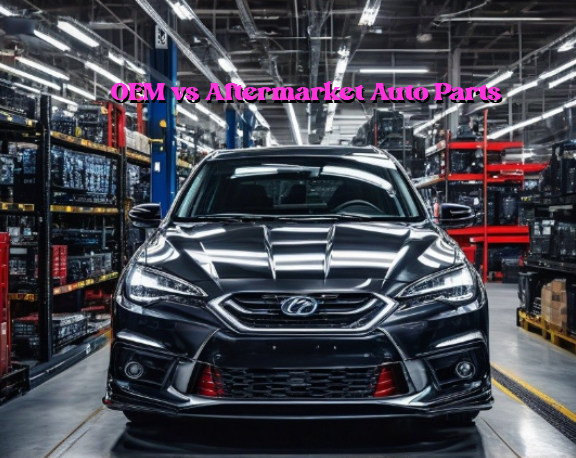OEM auto part or aftermarket part? Debatable! Do you know the difference, and does it matter? Aftermarket parts usually meet the need for the repair. There are times when we recommend only using an OEM or Original Equipment Manufacturer part, as that part has been designed specifically for that make and model. In some cases, OEM parts may be the only option, as aftermarket parts may not be available. Today, we talk about the pros and cons for OEM and aftermarket auto parts, as well as the differences between them.

What Is Aftermarket Auto Part?
Pros
They’re usually cheaper. They may have the same warranty or even better, and many times more availability for that part. When looking up apart for repair, we may find a multitude of options with aftermarket parts. Some aftermarket parts claim to be better than OEM parts as they have worked out the issues the OEM part experienced.
Cons
The fit of aftermarket parts may not be optimal, especially when replacing catalytic converters. And also, they may not be made of the same material, which can cause failure quicker, having to do that repair all over again. Aftermarket catalytic converters may not meet the specifications needed to pass inspections when it’s time for your vehicle to be inspected. The warranty for aftermarket parts can be the same or possibly even better, as we offer a two year or 24,000 miles parts and labor warranty on our repairs with some exclusions.
What Is OEM Auto Part?
Pros
OEM auto parts offer several advantages, including perfect fit and compatibility with specific vehicle models, ensuring that they function exactly as intended without the need for modifications. These parts maintain the high quality and reliability expected from the original manufacturer, often outlasting cheaper aftermarket alternatives. Choosing OEM parts is straightforward since there’s typically only one version that matches each model, removing the guesswork and potential compatibility issues associated with aftermarket parts. Additionally, using OEM parts helps preserve the vehicle’s resale value as they are seen as more desirable by potential buyers.
Cons
OEM auto parts can be more expensive than aftermarket parts, as the automaker charges a premium for their branded components. This can make OEM parts less affordable, especially for older vehicles. Additionally, the availability of OEM parts may be more limited compared to aftermarket options, as automakers only produce them for a certain period of time. This can make it challenging to find OEM replacements, especially for older or discontinued models. Finally, while OEM parts are designed to the automaker’s exact specifications, some consumers may find that aftermarket parts offer comparable quality at a lower cost, depending on the part and the brand of the aftermarket option.
Aftermarket Auto Parts vs OEM Auto Parts
The main tradeoff is between cost and quality/compatibility. Aftermarket parts offer more affordability but potentially lower quality and fitment, while OEM parts provide an exact match but at a higher price. Many consumers find a middle ground by using a mix of OEM and reputable aftermarket parts, depending on the specific components needed. The decision often comes down to the vehicle’s age, budget, and the importance of the part being replaced.
Aftermarket Parts:
- Generally less expensive than OEM parts
- Wide availability from multiple manufacturers and retailers
- May not be made to the exact same specifications as the original part
- Quality can vary widely depending on the brand and manufacturer
- May not be covered under the vehicle’s warranty, unless explicitly approved by the automaker
OEM Parts:
- Made by the original manufacturer to the vehicle’s exact specifications
- Guaranteed to fit and function properly with the vehicle
- Typically more expensive than aftermarket options
- More limited availability, often only sold through the dealership or authorized retailers
- Usually covered under the vehicle’s warranty when used for repair/replacement
- Ensure continued proper functioning and performance of the vehicle
When You Shouldn’t Use Aftermarket Car Parts
The key takeaways are that for safety-critical components, precision parts, and technology-laden systems, it’s generally advisable to use OEM replacements rather than risk the potential issues that can arise from cheaper aftermarket alternatives. However, for some non-critical parts, reputable aftermarket options can provide significant cost savings.
Engine/Motor Mounts – OEM mounts often have advanced damping technology like fluid-filled chambers that aftermarket parts lack, leading to excessive vibrations.
Air-Fuel Sensors/Emission Components – These critical sensors play a vital role in the combustion process, so aftermarket parts are not worth the risk. The exception is to look for aftermarket parts made by the original OEM supplier.
Thermostats – A failed thermostat can potentially damage the engine, so it’s better to stick with the OEM part to ensure proper function and reliability.
Valve Cover Gaskets – Aftermarket valve cover gaskets have proven problematic, often leaking soon after installation, compared to the reliability of OEM gaskets.
Supplemental Restraint System (SRS) Components – Parts like airbags require precision manufacturing, so it’s important to use the OEM components to ensure proper function and safety in the event of a collision.
When it comes to sourcing high-quality OEM die casting parts, Junying is an excellent choice. As an established manufacturer with over 20 years of experience, Junying specializes in producing precision OEM die casting components for a wide range of industries, including automotive, electronics, and machinery.

